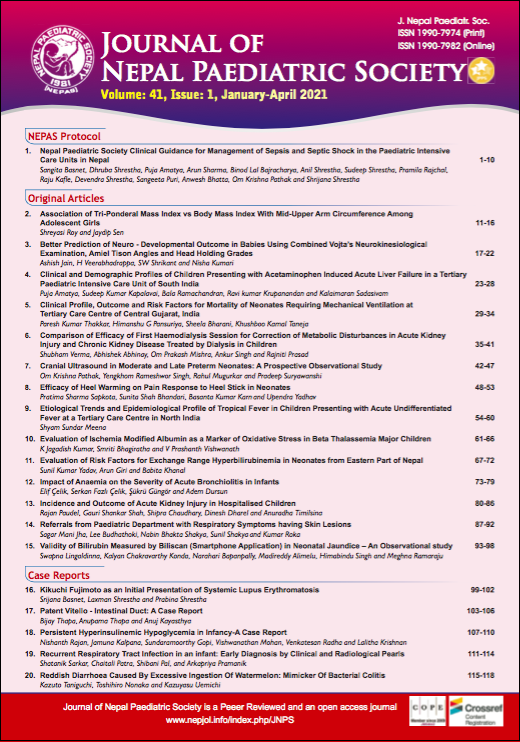Evaluation of Ischaemia Modified Albumin as a Marker of Oxidative Stress in Beta Thalassemia Major Children
DOI:
https://doi.org/10.3126/jnps.v41i1.29931Keywords:
β-thalassemia major, Ferritin, Ischemia modified albumin (IMA), Oxidative stressAbstract
Introduction: Iron overload in thalassemia catalyses the production of a variety of reactive oxygen species leading to cumulative cell damage. Ischemia modified albumin (IMA) is an end product of oxidative stress. It is imperative to pick up oxidative stress early in order to prevent the organ damage in thalassemia. Therefore this study was undertaken to estimate IMA levels and to see the correlation between ferritin and IMA to establish whether ferritin can be a proxy marker for oxidative stress.
Methods: A total of 76 children were included in the study out of which 46 were diagnosed cases of β- Thalassemia major and 30 formed the healthy controls. Pre transfusion haemoglobin, AST, ALT, ferritin and IMA levels were estimated and compared with healthy control children. Correlation was drawn between haemoglobin, AST, ALT, ferritin with IMA.
Results: There is significant elevation in the level of IMA and ferritin in children with Thalassemia major as compared to the healthy controls (p = < 0.001). There was a significant positive correlation between ferritin and IMA and a significant negative correlation between haemoglobin % and IMA. Regression relationship between ferritin and IMA established that IMA (ng/ mL) = 246.118 + 0.829 (Ferritin ng/dL).
Conclusions: IMA levels were significantly elevated in β- thalassemia major children and correlated positively with ferritin levels. By establishing a regression relationship between ferritin and IMA levels, we can fairly estimate the levels of IMA. Hence, we can utilise ferritin as a proxy marker of oxidative stress instead of IMA.
Downloads
Downloads
Published
How to Cite
Issue
Section
License
Authors who publish with this journal agree to the following terms:
Authors retain copyright and grant the journal right of first publication with the work simultaneously licensed under a Creative Commons Attribution License that allows others to share the work with an acknowledgement of the work's authorship and initial publication in this journal.
Authors are able to enter into separate, additional contractual arrangements for the non-exclusive distribution of the journal's published version of the work (e.g., post it to an institutional repository or publish it in a book), with an acknowledgement of its initial publication in this journal.
Authors are permitted and encouraged to post their work online (e.g., in institutional repositories or on their website) prior to and during the submission process, as it can lead to productive exchanges, as well as earlier and greater citation of published work (See The Effect of Open Access).



